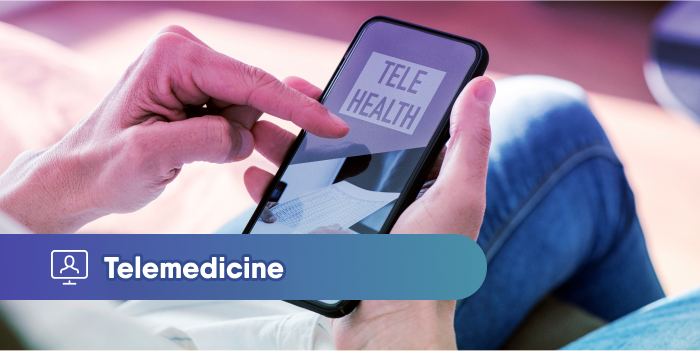Why You Need to Offer Telehealth Services
The COVID-19 pandemic poses a serious threat to healthcare providers and patients. Telehealth services offer ways to mitigate these safety concerns....

The COVID-19 pandemic changed how many industries manage their day-to-day operations, healthcare included. With lockdowns that prevented people from leaving their homes and the threat of spreading COVID-19 in waiting rooms or to providers, telehealth became an essential method of delivering healthcare across the United States. With the COVID-19 pandemic continuing to disrupt the healthcare system, telehealth continues to be a much-needed resource.
Based on the COVID-19 data tracker of the United States Centers for Disease Control and Prevention (CDC), more than 1% of the country’s population tested positive for COVID-19 as the number continues to rise every day. As of this date, there is no cure for COVID-19; but one of the most robust solutions implemented across the globe is the distribution and administering of COVID-19 vaccines.
More than 173 million people in the US are now fully vaccinated, or 64.9% of the country’s total population. As more people are lining up to receive their COVID-19 vaccine, industries are slowly getting back on their feet and readjusting their operations to fit in the new normal. Though no one knows when the virus transmission will end, experts believe that the new normal in 2025 will likely be more tech-driven. People and industries may come to rely more on digital connections, such as telehealth in healthcare.
However, the integration of digital connections and telehealth in the healthcare industry occurred even before the pandemic. But telehealth’s use was uncommon.
What was considered first as an option of healthcare service, telehealth becomes a central healthcare delivery tool in response to the COVID-19 outbreak as access to care becomes difficult.
First identified in December 2019 as a coronavirus-related pneumonia outbreak in Wuhan, China unfolded into becoming a global pandemic: the 2019 novel coronavirus, later called COVID-19.
Here’s a list of important events that happened in the US healthcare setting during the early months of the COVID-19 outbreak:
In January 2020, the CDC confirmed the first COVID-19 case in the US when a Washington resident, having returned from Wuhan, was diagnosed with COVID-19 through polymerase chain reaction testing. The CDC deployed an investigation team in Washington to trace close contacts and determine if anyone else becomes ill.
In March 2020, the US government declared the COVID-19 outbreak a national emergency, releasing billions of dollars in federal funding to fight the pandemic. States and local governments receive response funds and other assistance to contain the spread of the virus and protect the economy against its mounting impact.
On March 4, 2020, the CDC issued new guidelines allowing anyone to get tested for COVID-19 without restrictions. Previously, residents with travel and exposure histories and those with severe symptoms could only get tested.
On March 17, 2020, the Centers for Medicare & Medicaid Services (CMS) temporarily expanded its telehealth rules as a means to protect the elderly from potential exposure to COVID-19. The expansion also allows covering telehealth visits the same as regular in-person visits. Telehealth became available in a broader range of facilities, including nursing home residents.
On March 19, 2020, California was the first state to issue a stay-at-home order mandating residents to only go out for essential needs. The order also instructs healthcare systems to prioritize providing services to those who are the sickest. A few days before this announcement, the CDC advised no gatherings of 50 or more people in the US. At the same time, the government urged the public to avoid groups of more than ten people.
Across the US, stay-at-home orders took effect as government operations and non-essential businesses were closed from March 2020. The re-opening of industries and operations varied in every state.
Former US president Donal Trump signs the Coronavirus Aid, Relief, and Economic Security (CARES) Act into law on March 27, 2020, providing $2 trillion in aid to hospitals, small businesses, and state and local governments.
In April 2020, a Gallup poll reported that one out of seven Americans says they would avoid going into hospitals or clinics to seek care for fever or dry cough, the most common symptoms of COVID-19. The reason behind this hesitation, according to the poll, is to avoid high medical treatment costs.
Almost five months into the pandemic, low-income areas in the US face inadequate intensive care unit beds. Hospitals transfer their sickest patients to care facilities in wealthier areas.
The COVID-19 can infect anyone, especially those working in a healthcare setting. According to the most recent data from The Guardian, more than 3,600 US healthcare workers lost their lives because of COVID-19.
Telehealth emerged as a critical strategy during the COVID-19 pandemic to provide continuous patient care regardless of stay-at-home mandates. The expansion of its services continues to aid a dire healthcare crisis from worsening by providing Americans with digital connections for their healthcare needs.
After declaring the COVID-19 pandemic a national emergency, the US government responded by funding the COVID-19 Telehealth Programs, part of the CARES Act, to help healthcare providers administer telehealth and connected care services to patients’ homes or remote locations.
The program provided $200 million in funding for telecommunications, information, and virtual devices to provide critical connected patient care services.
Before the pandemic, a survey found that only 18% of physicians used telehealth to deliver healthcare services, while less than 10% of Americans had experience with telehealth. Although telehealth services were already available in the US pre-COVID-19, its adoption was still uncommon.
From March to April 2020, following a surge of COVID-19 cases, US case reports suggest that telehealth use went from less than 1% of visits to as much as 80%. According to a CDC report, most telehealth visits are from patients seeking medical treatment other than COVID-19.
The increase in telehealth may be attributable to policymakers and healthcare institutions eliminating almost all financial, regulatory, and technical barriers that previously prevented telehealth expansion.
As part of the CARES Act, the Families First Coronavirus Response Act included a provision requiring health insurance providers to waive cost-sharing for COVID-19 testing services. Therefore, patients who were potentially sick with COVID-19 who met with a doctor through telehealth before testing were not charged.
With more patients seeking remote healthcare access, telehealth transformed into a 21st-century strategy to provide essential healthcare services for people during a global pandemic.
In general, telehealth technology allows physicians to see their patients at home or another location and deliver healthcare services using real-time techniques, such as live video conferencing, remote patient monitoring (RPM), a secured stored-and-forward technology, and mobile health.
With 90% of Americans using the Internet, telehealth is more accessible than before. Healthcare providers and professionals integrated the use of information and communication technology (ICT) into their service and practice as a front-line technique in the battle against the COVID-19 outbreak. Telehealth offered numerous benefits during the pandemic as healthcare providers and patients found value in the option of virtual care.
According to a statement released by the American Hospital Association (AHA) in March 2021, telehealth has provided a critical way for patients to continue to access healthcare during the COVID-19 pandemic. The organization lauds its appreciation of the flexibilities implemented during the COVID-19 outbreak, as hospitals and health systems can provide patient care in the safety of an individual’s home.
Here are some of the additional benefits of telehealth during the COVID-19 pandemic in the US:
Physicians in quarantine because of COVID-19 exposure could still use remote healthcare services to care for patients, maximizing their practice. Whereas patients in the hospital or quarantine receive treatment without leaving home, reducing the risk of exposure for others. That significantly contributed to slowing the spread of COVID-19 and reduce pressure on medical staff.
One of the critical factors that reduces COVID-19 transmission is identifying and immediate isolation of suspected or positive cases. With telehealth, screening patients who may have COVID-19 symptoms is possible and more accessible.
Telehealth helps in reducing the number of emergency room hospital visits for non-COVID-related minor or life-threatening illnesses. It offers low-risk urgent care for patients so healthcare workers at hospitals can focus on patients who need critical care.
Also, as a remote form of medical service, telehealth minimizes the use of personal protective equipment (PPE) among healthcare providers — a valuable resource.
Telehealth saves Americans on average $19 to $121 in healthcare costs, primarily by avoiding emergency department visits.
Through secured communication channels, healthcare providers or practitioners may communicate with their patients regarding COVID-19 vaccination, such as encouraging them about the benefits of getting vaccinated and guiding them along the process.
Telehealth creates new revenue streams for US healthcare providers by expanding a practice’s reach into new communities or rural areas without moving locations. That helped many small medical practices to survive during the pandemic.
Many AHA members observed greatly improved health outcomes of patients because they no longer canceled or missed their appointments due to connecting with their providers remotely.
Thanks to telehealth, healthcare providers have had millions of successful encounters with patients since the COVID-19 pandemic hit to ensure maintaining good health is always a priority. Telehealth plays a central role in healthcare delivery and in protecting doctors and patients during a global crisis and in the future of healthcare.
Overall, telehealth slows the COVID-19 transmission by keeping doctors and patients out of waiting rooms and healthcare facilities. Moreover, it allows non-COVID-related patients to continue receiving care, which is particularly beneficial for at-risk older people during the pandemic.
As the COVID-19 outbreak continues to spread across the US, unprecedented demands for comprehensive and alternative healthcare services remain. Telehealth addresses the many critical challenges in providing healthcare solutions during a national health crisis, and with great success.
As the US government aims to strengthen global health security to prevent, detect, and respond to infectious disease outbreaks, like COVID-19, telehealth services will be an invaluable tool in pandemic planning and response in the long run. But it should also remain a valuable part of healthcare in the future when national emergencies are not in effect for its convenience and high patient satisfaction rate.

The COVID-19 pandemic poses a serious threat to healthcare providers and patients. Telehealth services offer ways to mitigate these safety concerns....

Healthcare providers love telemedicine for various reasons related to their practice and ensure that they continue to honor their sworn duty to...

You may not believe it, but telehealth has been around longer than you may think. The idea of telehealth started in the late 1800s from an article...